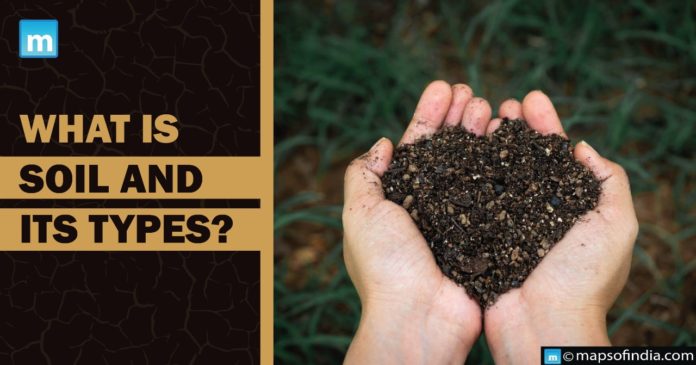What is Soil? – A Comprehensive Overview
Soil is formed through a complex process influenced by several factors, including relief (topography), parent material, climate, time, biodiversity, and human activities. India, with its diverse topography, landforms, climatic zones, and flora, exhibits a wide range of soil types. The main components of soil include mineral/rock particles, fragments of decomposed organic materials, soil water, soil air, and living organisms. These components interact and contribute to the formation of soil through the process of pedogenesis.
Soil is composed of different horizons or layers. The topsoil, known as Horizon A, is the uppermost layer where organic matter has combined with minerals, nutrients, and water necessary for plant growth. Below the topsoil is the subsoil, known as Horizon B, which has a higher concentration of minerals and less organic matter. It acts as a transition zone between the topsoil and the next layer. The lowest layer is Horizon C, which consists of weathered and decomposed rock material. This layer serves as the parent material for the layers above and is the initial step in soil formation.
How many types of soils are found in India?
The Indian Council of Agricultural Research (ICAR) has categorized soils in India into eight types.
A Comprehensive Overview – Eight Types of Soils Found in India
1. Black Soil
The black soil, also known as regur or black cotton soil, is derived from volcanic rocks and lava. It is characterized by its dark color and high clay content. Black soil is found in the Deccan Plateau regions of Maharashtra, Gujarat, Madhya Pradesh, Karnataka, and Tamil Nadu. It has excellent water-holding capacity and is known for its fertility. Cotton is the main crop grown in black soil, but it also supports the cultivation of wheat, millet, tobacco, and oilseeds.
2. Alluvial Soil
Alluvial soil is formed by the deposition of river sediments. It is rich in minerals, particularly potash, lime, and phosphoric acid, making it highly fertile. Alluvial soil is predominantly found in the Northern Plains and coastal regions of India. It is divided into two types: new alluvium (khadar), which is found in floodplains and is rich in silt, and old alluvium (Bangar), which is found in elevated areas and contains a higher proportion of clay. Major crops grown on alluvial soil include wheat, rice, sugarcane, maize, legumes, and oilseeds.
3. Laterite Soil
Laterite soil is typical of monsoon regions with high rainfall. It is formed by the leaching of soils rich in iron oxide, aluminum, lime, and silica. Laterite soils are found in parts of Karnataka, Tamil Nadu, Kerala, Madhya Pradesh, Assam, and Odisha. They are generally low in fertility, organic matter, nitrogen, phosphate, and calcium. However, with the application of manures and fertilizers, they can support the growth of crops like cashew nuts, rubber, tea, and coconut. Laterite soil hardens when exposed to air, making it suitable for making building bricks.
4. Mountain Soil
Mountain soil is found in forested areas of hilly regions, primarily in the Himalayas. The texture of mountain soil varies depending on the slope and elevation. Valley sides typically have loamy and silty soils, while upper slopes have coarse-grained soils. These soils are affected by erosion and denudation and often have lower organic matter content. However, lower valleys have fertile soil suitable for agriculture.
5. Desert Soil
Desert soil, also known as arid soil, covers arid regions of India, primarily in western Rajasthan. It is characterized by a sandy to gravelly texture, low moisture content, and low organic matter. These soils are naturally saline and have a high concentration of soluble salts. However, with proper irrigation and management techniques, they can be made suitable for agriculture. Desert soil is deficient in nitrogen but has a typical phosphate level. Certain crops like barley, pulses, and millets can be cultivated in these areas.
6. Alkaline Soils
Alkaline soils are characterized by high levels of sodium, potassium, and magnesium. They are found in dry and semi-arid regions with inadequate drainage. These soils are infertile and lack calcium and nitrogen. However, their fertility can be improved by enhancing irrigation and drainage, adding gypsum to reduce the alkalinity, and cultivating crops that can tolerate high salt content. Alkaline soils are found in states like Punjab, Uttar Pradesh, Bihar, Rajasthan, Haryana, and Maharashtra.
7. Red & Yellow Soil
Red & Yellow soils, collectively known as lateritic soils, cover a significant portion of India. They are formed in areas with moderate to low rainfall, particularly in the eastern and southern parts of the Deccan Plateau. These soils have a reddish or yellowish color due to the presence of iron oxide. Red loamy soil is found in the Western Ghats’ piedmont zone, while yellow soil is prevalent in parts of Chhattisgarh, Odisha, and the southern Middle Ganga Plain. Red and yellow soils are generally less fertile and have lower organic matter, nitrogen, and phosphorus content compared to other soil types. Crops like wheat, cotton, oilseeds, millets, tobacco, and pulses are grown in these soils.
8. Peaty and Marshy Soils
Peaty soil is formed in areas with high organic matter accumulation due to a humid climate. It is characterized by its black color, acidic nature, and low levels of phosphorus and potash. Peaty soil is found in certain districts of Kerala. Marshy soil, on the other hand, is found in coastal regions such as the Sundarbans in West Bengal, as well as in parts of Tamil Nadu, Bihar, and Uttaranchal. Marshy soil is black, highly acidic, and contains a significant amount of soluble salts. It is typically found in areas with mangrove vegetation. These soils are not suitable for agriculture due to their high acidity and low nutrient content.




